RESTORATION & CONSERVATION SERVICES | FINE ART RESTORATION | PAINTING RESTORATION
Painting Restoration
“I am absolutely thrilled with the painting thank you! I am loving having it back. Thank you so much to you and your team for all your work and kindness, which is much appreciated”
– Jane R, Private Collector and Hiscox policyholder
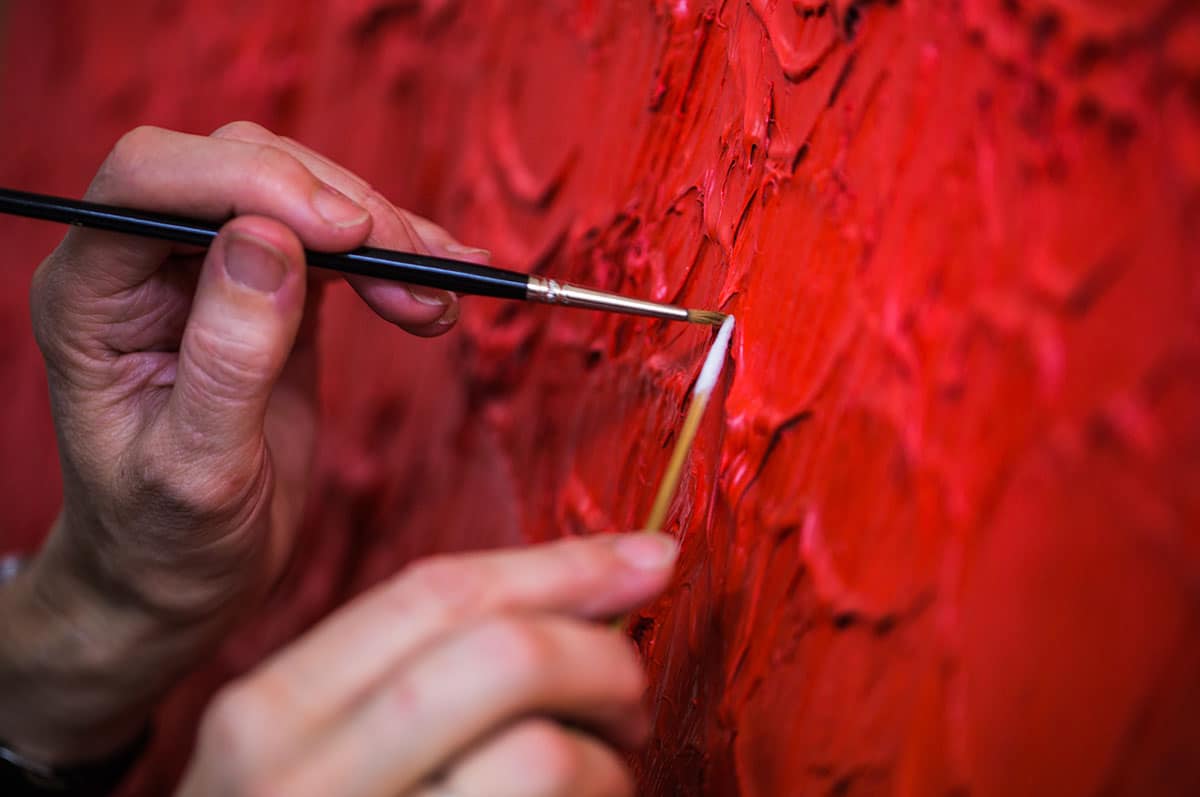
“May I say, once again, how thrilled I am with the painting and frame – many, many thanks for turning my personal catastrophe into such a delight!”
– Angela, Private Collector
Our painting restoration department carries out surface and structural restoration to a wide range of paintings. As with all our treatments, painting restoration work is preceded by a consultation and collectors rely on our impartial advice about the potential short and long term implications of treatment, informed by our knowledge of art market conditions.
All our painting restoration treatments are created around the material composition of each painting, a scientific approach that achieves outstanding results without having to resort to aggressive or unsympathetic techniques.
We correct age-related disintegration and damage, for example removing overpaint and historic restoration, relining canvases and stabilising flaking paint. We also fill and retouch paint loss, and remove discoloured varnish, replacing it with a modern conservation-grade equivalent.
Our painting restoration department restores artworks that have suffered accidental damage, been displayed or stored in incorrect atmospheric conditions, as well as paintings that have been devastated by fire or flood.
Painting Restoration Case Studies
Sir John Glanville – 17th Century Oil Painting Restoration
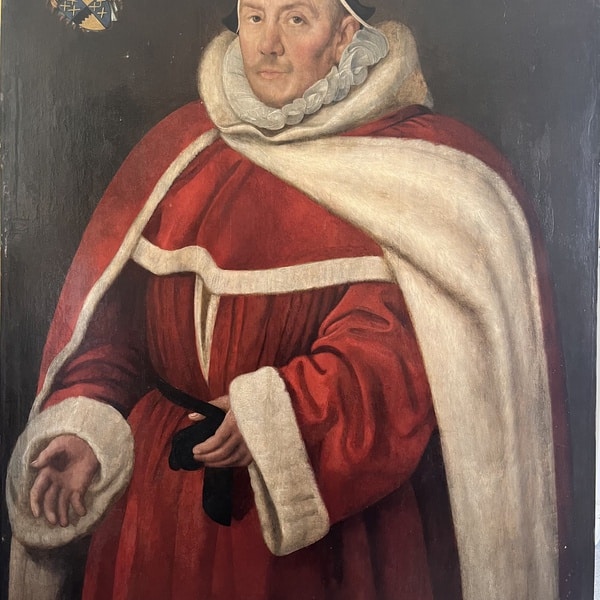
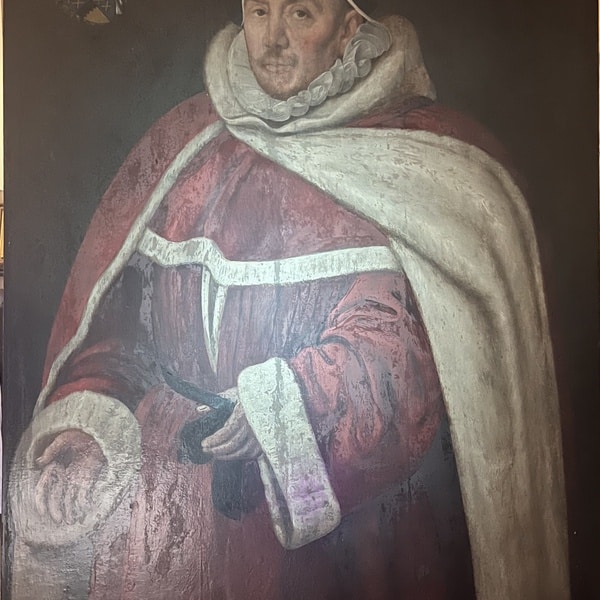
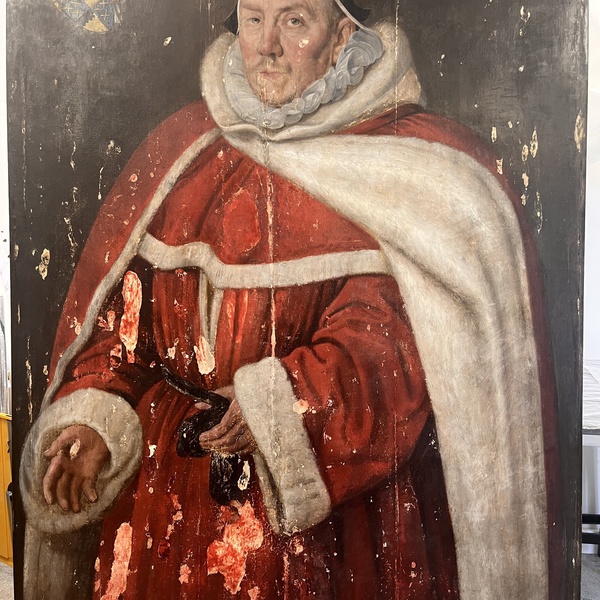
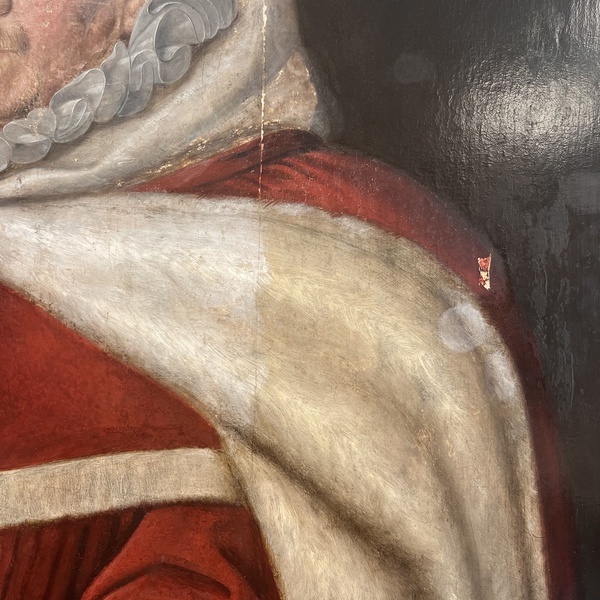
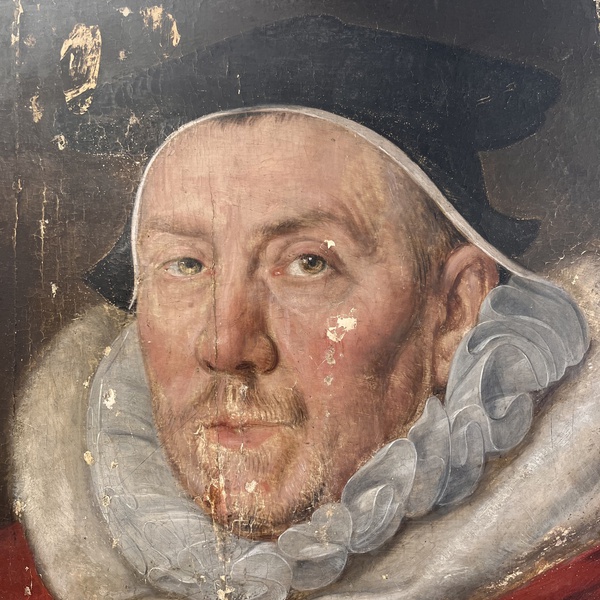
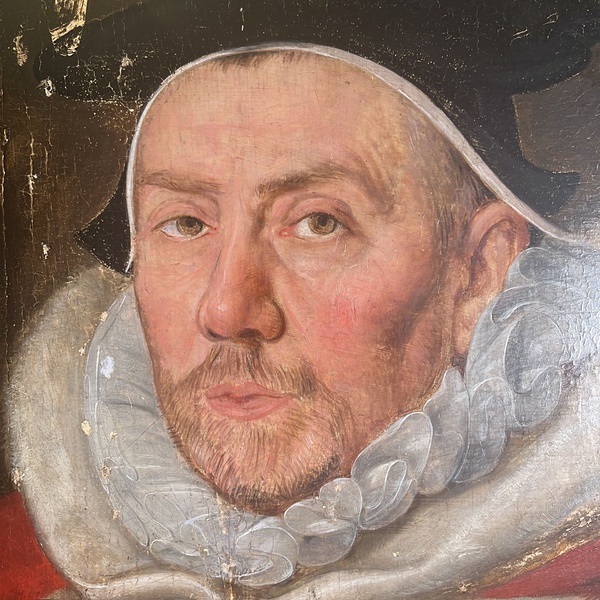
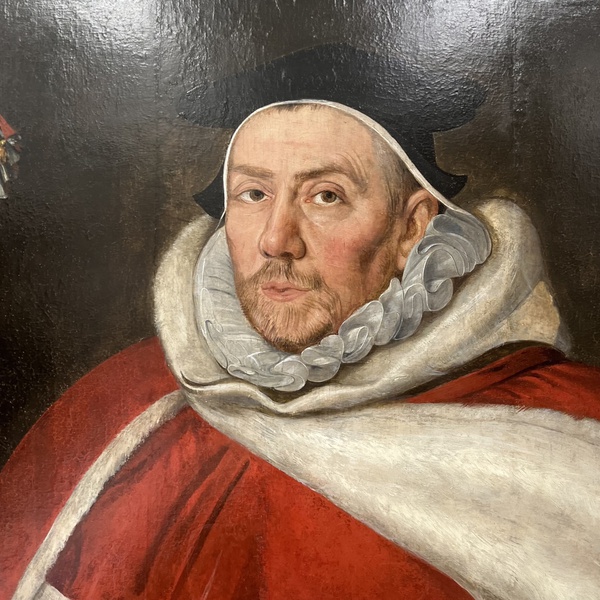

Painted by an unknown artist, this 17th Century oil on panel painting depicts Sir John Glanville the younger (1586 – 1661), an English barrister and politician who sat in the House of Commons at various times between 1614 and 1644. The painting forms part of The Honourable Society of Lincoln’s Inn’s impressive art collection.
The portrait came into our painting restoration studio with numerous discoloured fills, retouching and yellowing varnish; all of which were visibly detracting from the painting.
When our painting restoration team initially examined the work, they discovered that the oil painting appeared to have been extended, presumably as part of an historic painting restoration treatment. They also noted that the painting had a cradle support on the back, believed by our painting restoration team to have been added during the 19th Century.
Our Painting Restoration team started by removing particulate dirt from the front and back of the panel painting and consolidating any flaking paint. They then surface cleaned the painting using an enzyme solution.
Following tests to establish the optimum method, the yellowed varnish was removed, along with the majority of the aged and discoloured retouching. More tenacious retouching was removed using IMS. This revealed to our painting restoration team that a lot of the original paintwork had been painted over. As this original paint was in good condition, our painting restoration team opted against replacing the retouching.
Our painting restoration team begun the process of retouching by applying a varnish to the original painted surface. This provides a barrier between the artist’s paint and our retouching work, ensuring that our restoration is non-invasive and reversible. Once the varnish had dried, our painting restoration team then retouched losses across the whole of the painting. Overall, more than ten different pigments were used in combination with aldehyde resin to match the gloss of the original painted surface.
Finally, our painting restoration team applied a spray varnish to saturate the painting and achieve an appropriate level of gloss finish.
19th Century Family Portrait Painting Restoration
“I asked Plowden & Smith to advise on the restoration work that might need to be done on a family painting that I have recently acquired. They gave me detailed advice and then undertook the restoration work. Their conservator who did the work spent time with me and my wife after doing the work, explaining in detail what had been done and answering various questions about the painting and the techniques involved in doing the restoration work. The painting now looks transformed and it is a great pleasure to have it hanging on one of our walls.”
– Geoffrey, Private Collector
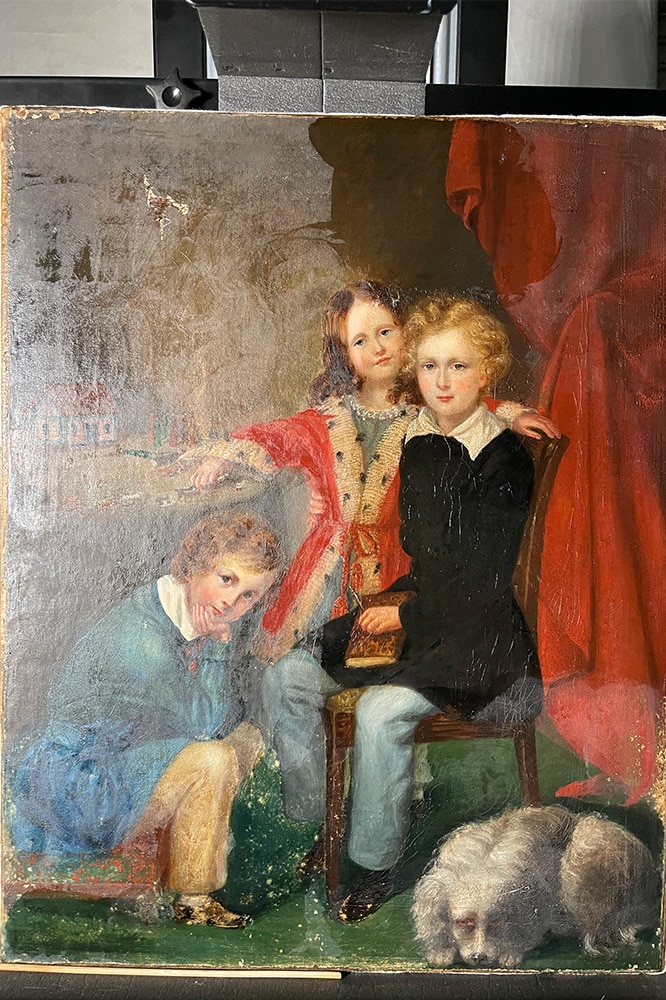
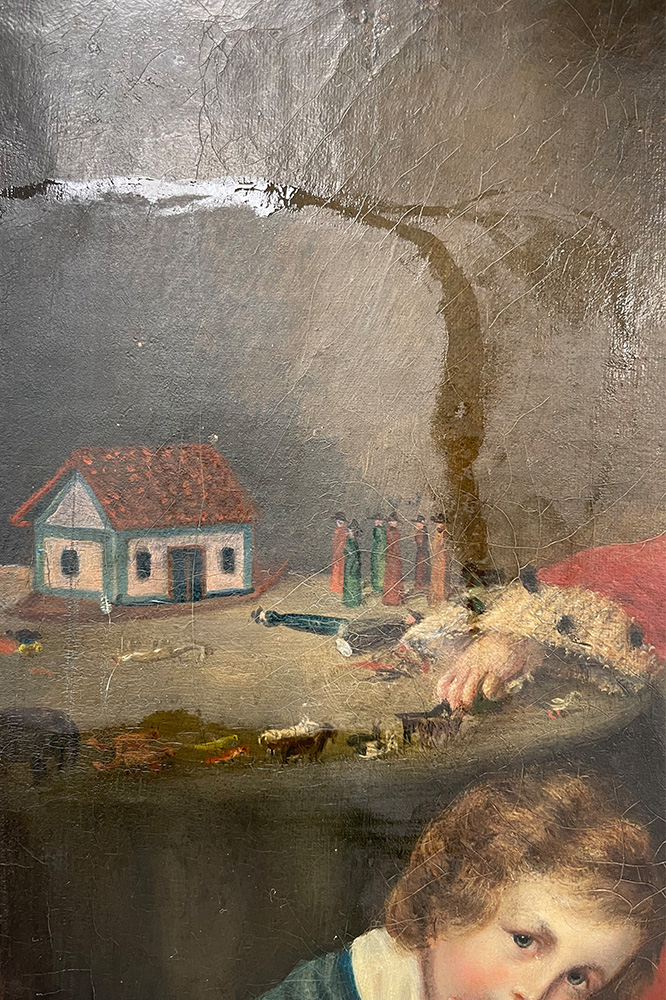
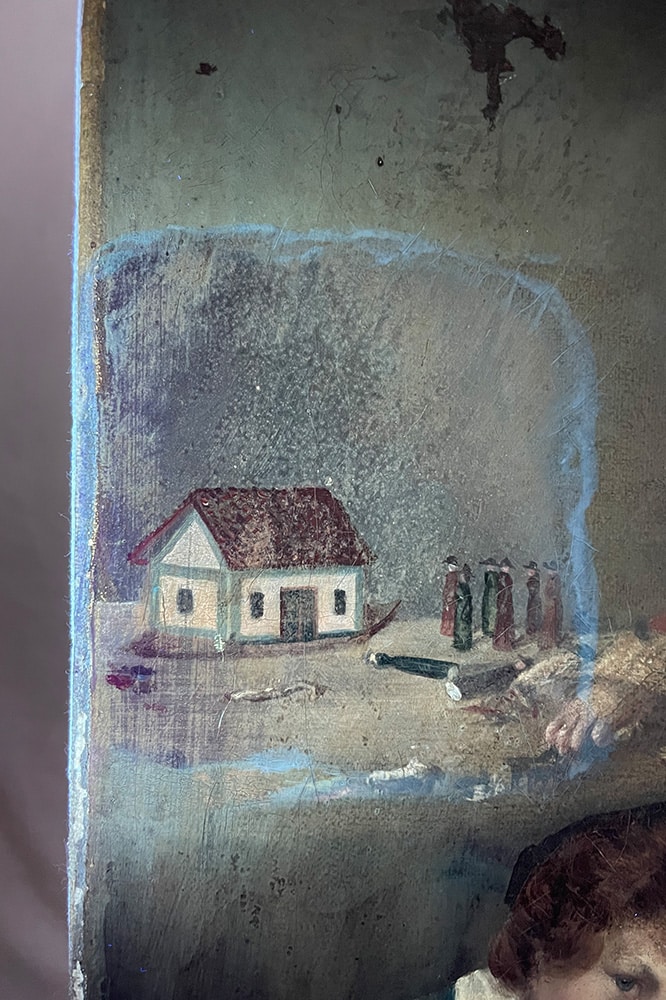
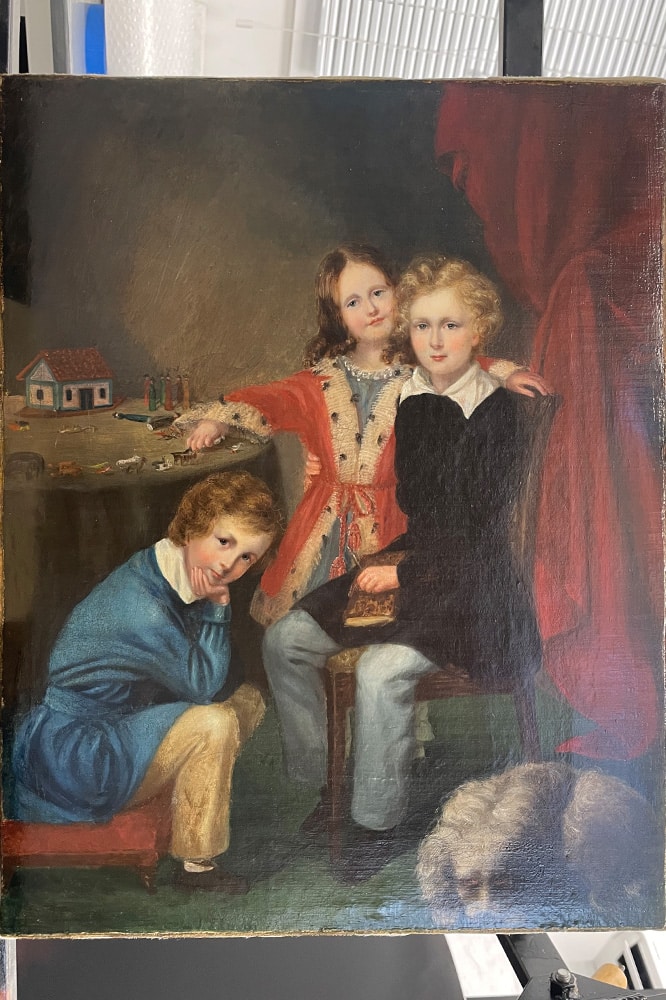
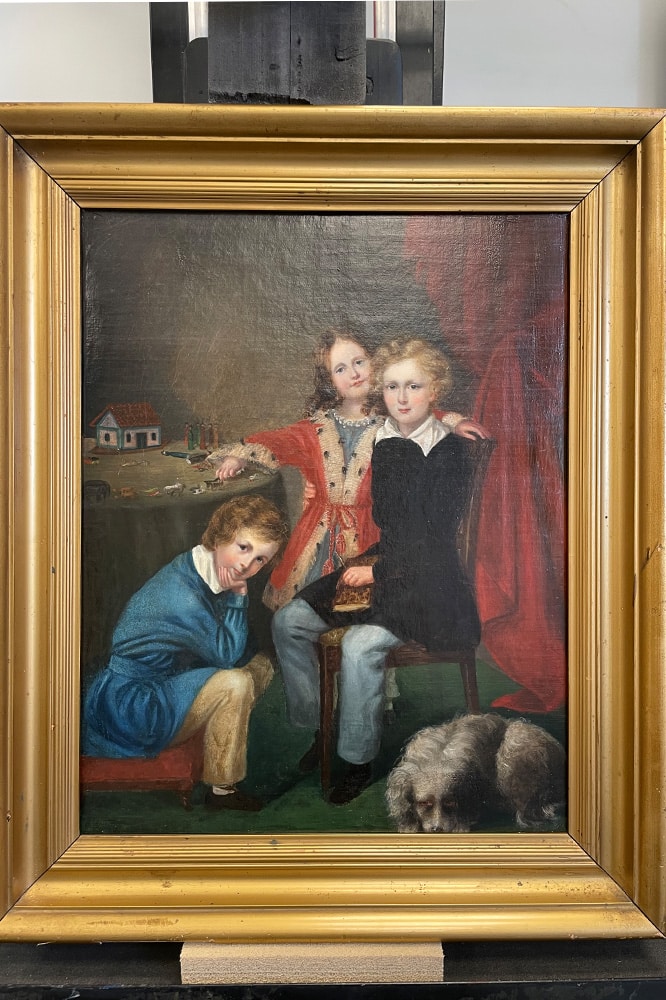
This family portrait dates from the mid-19th Century. Its current owner asked our painting restoration department to revive the appearance of their much-loved painting and help ensure its preservation for future generations.
After carefully assessing the artwork, our painting restoration team concluded that the painting was structurally sound; however, its appearance would be improved by removing and replacing the aged, discoloured varnish.
Preliminary tests revealed that the individual layers of the old varnish had different levels of solubility, meaning that each layer of varnish had to be removed one at a time.
In two places on the painting (the blue of the boy’s dress and the red curtains); the solubility of the original paint and the insolubility of the varnish meant that some varnish residue had to be left behind; a scenario that highlights the sort of unexpected challenges conservators may encounter during treatment, and the sort of choices they may make to achieve the overall best outcome.
After surface cleaning the painting and retouching any areas of loss, our painting restorer applied a conservation grade varnish with UV-protection characteristics; and the painting was returned to its original frame.
Small Oil on Canvas Painting Restoration
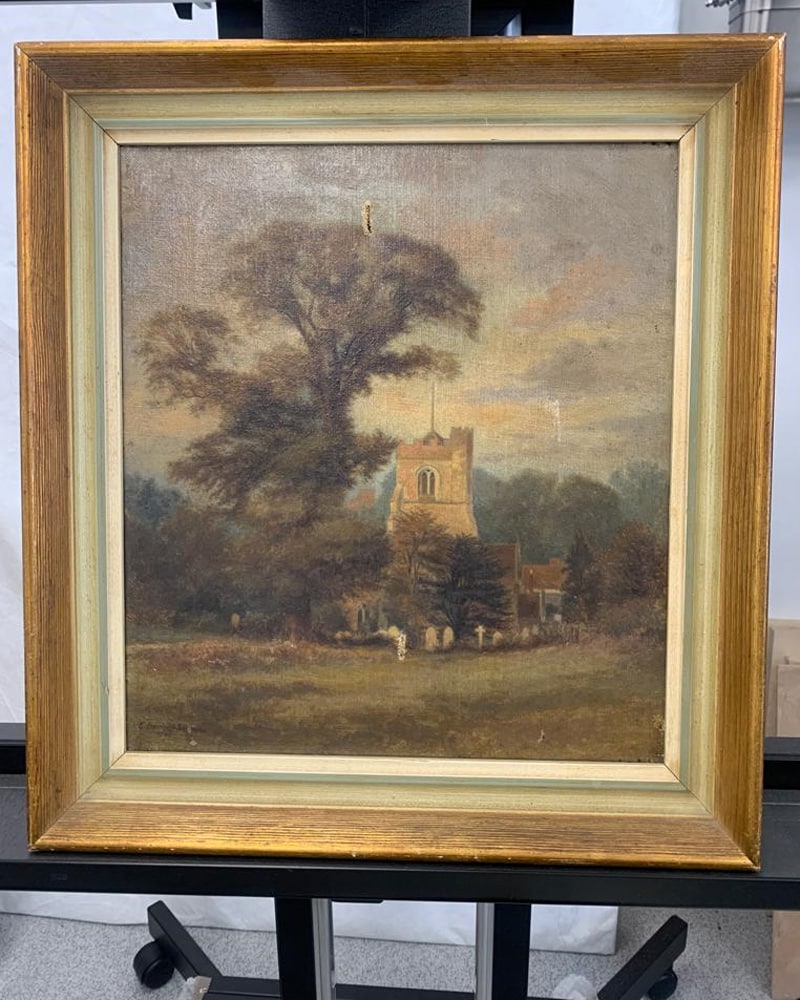
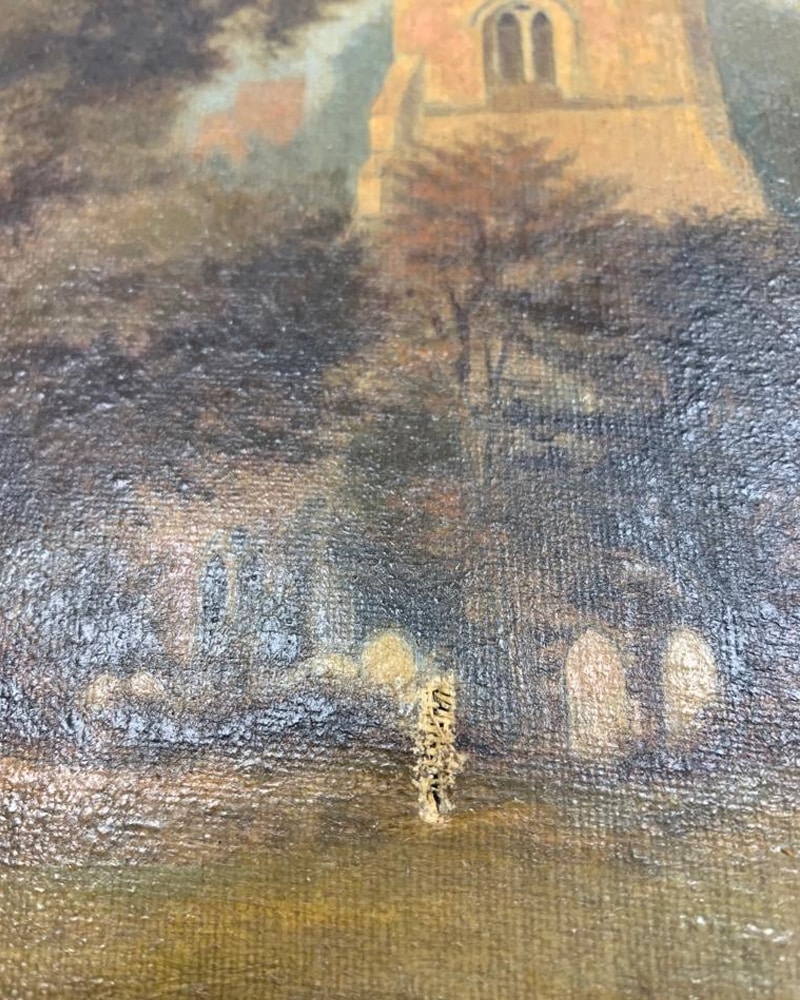
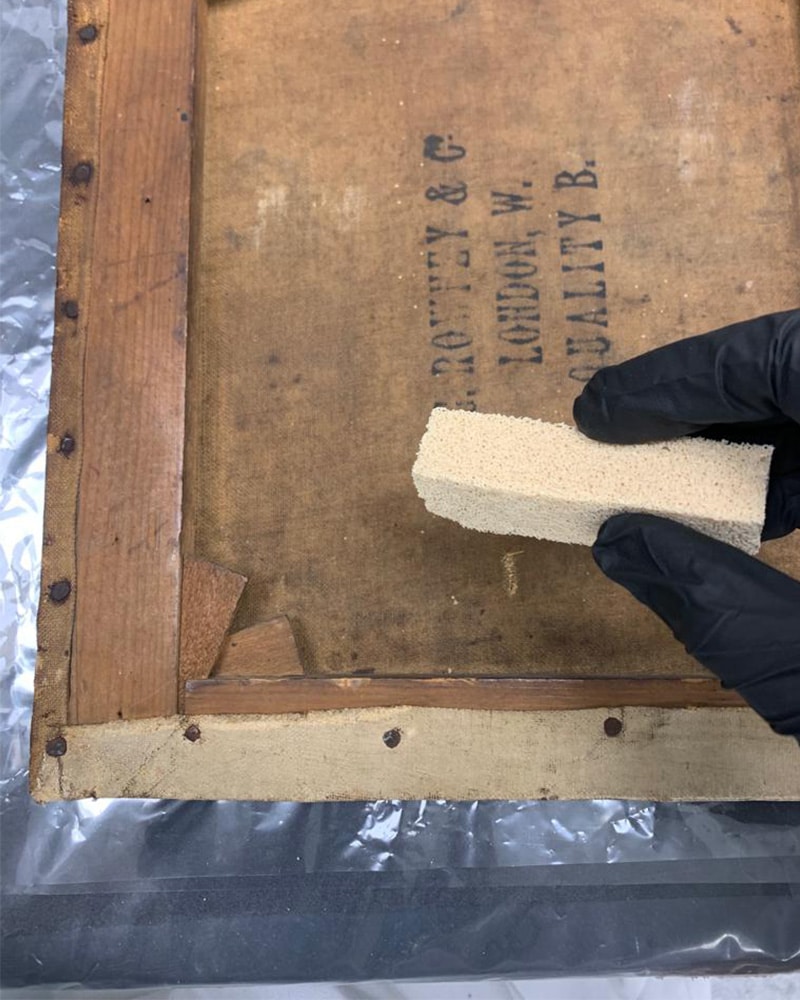
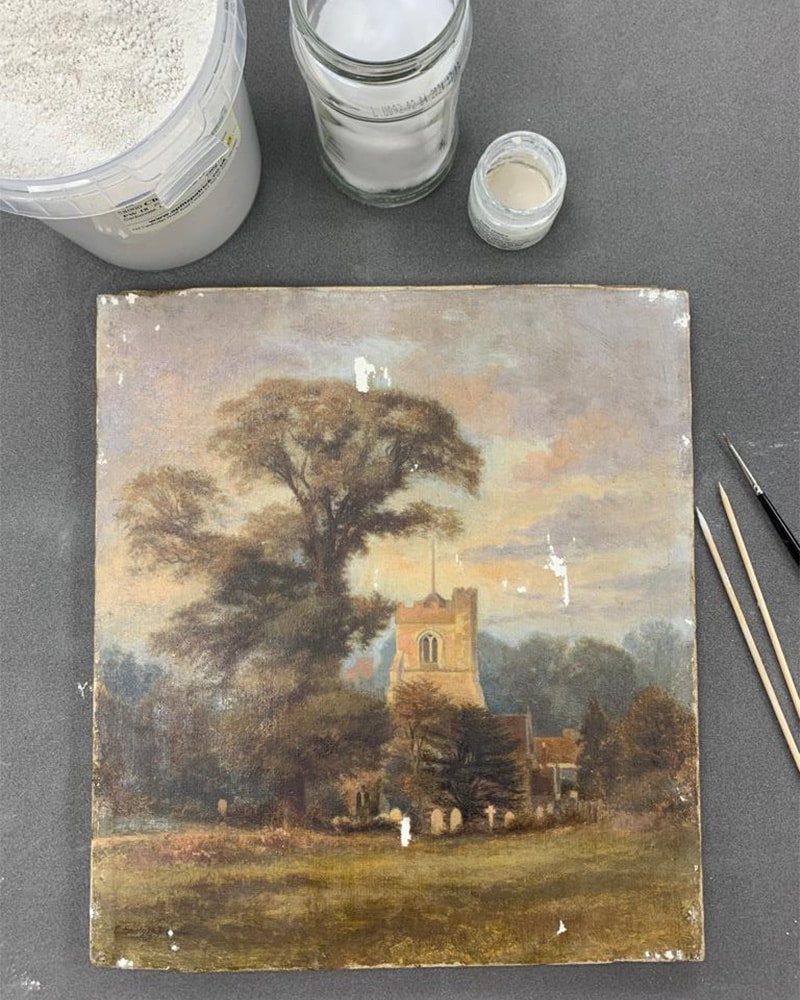
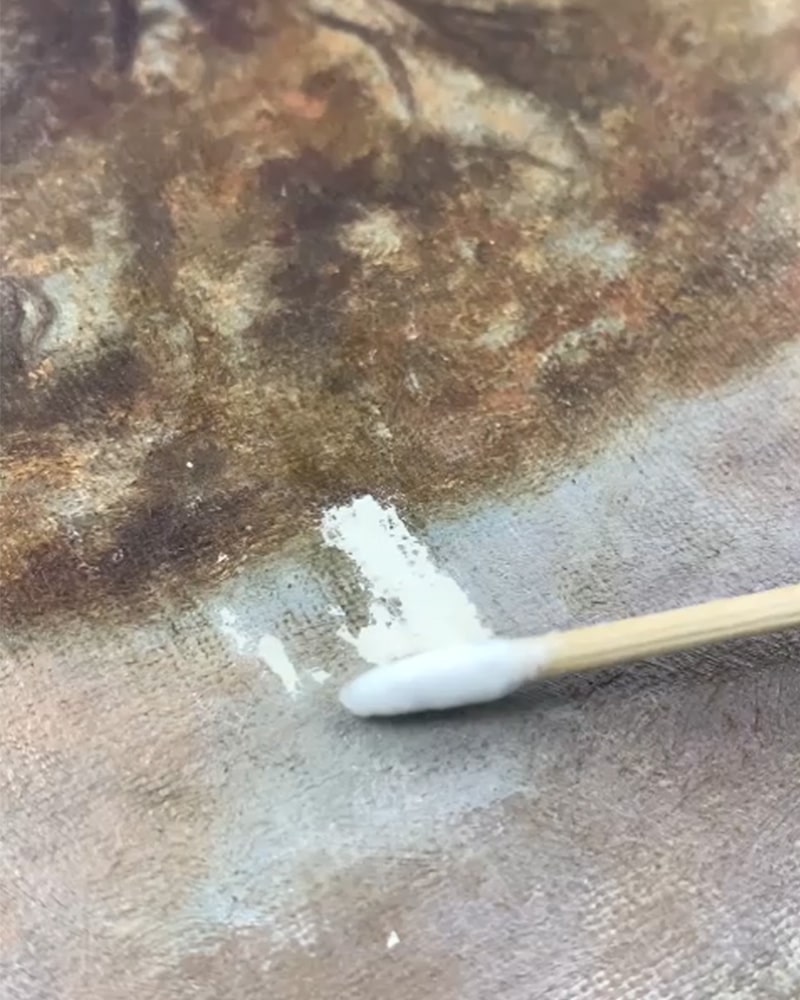
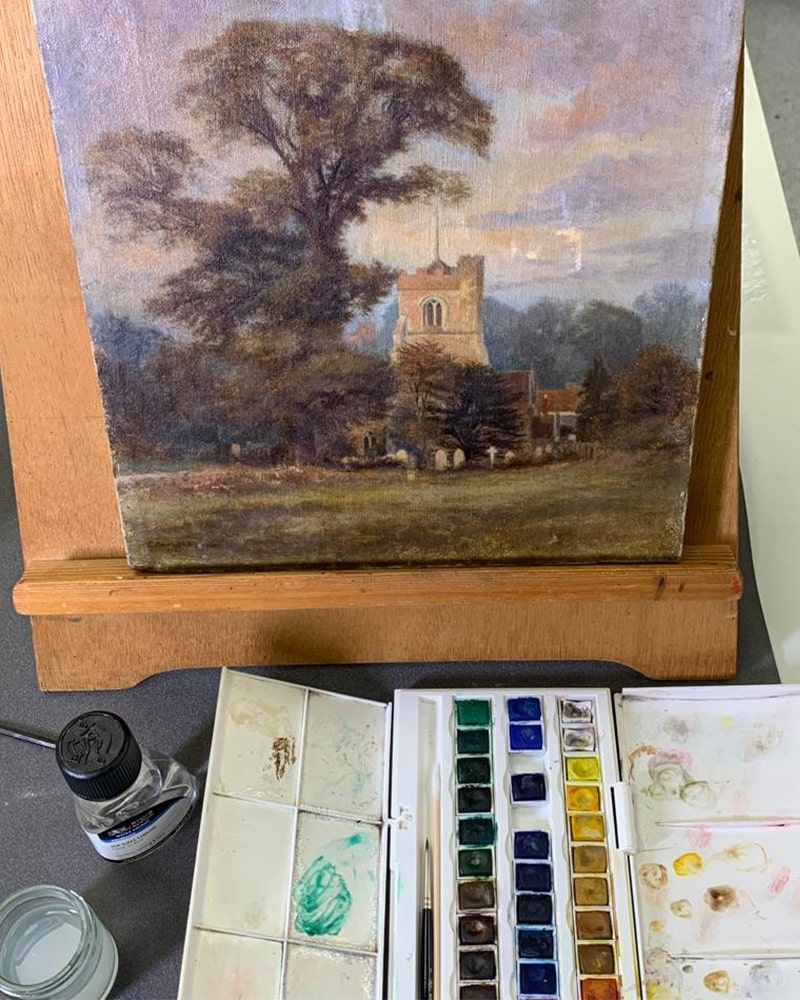
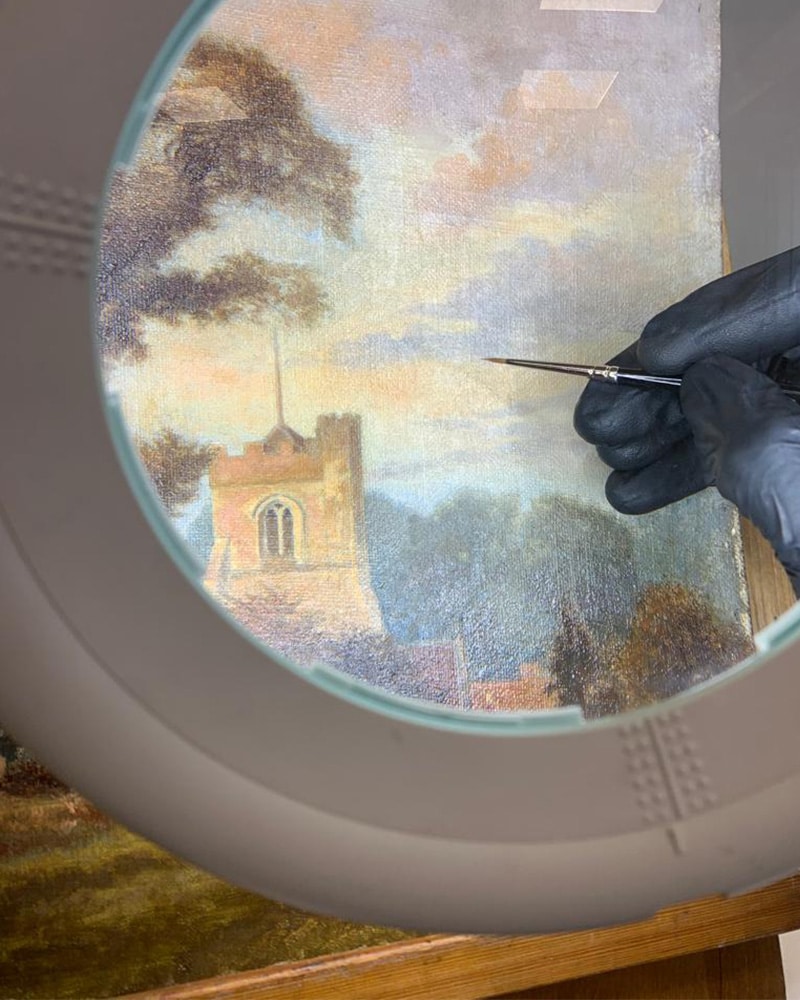
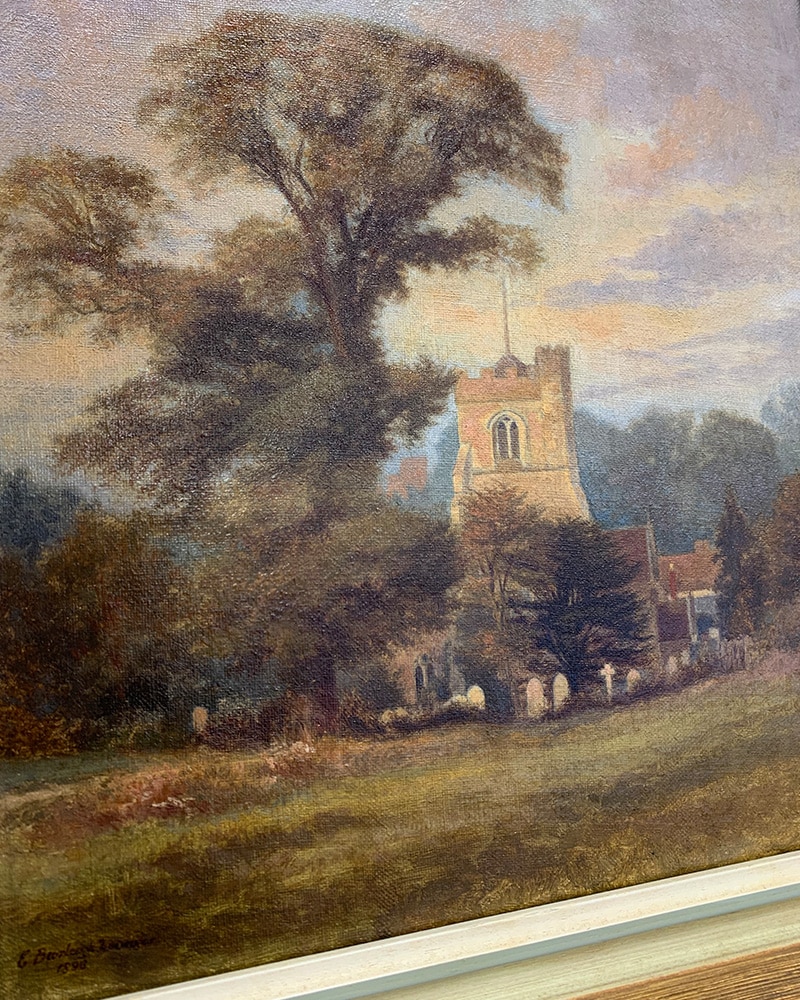
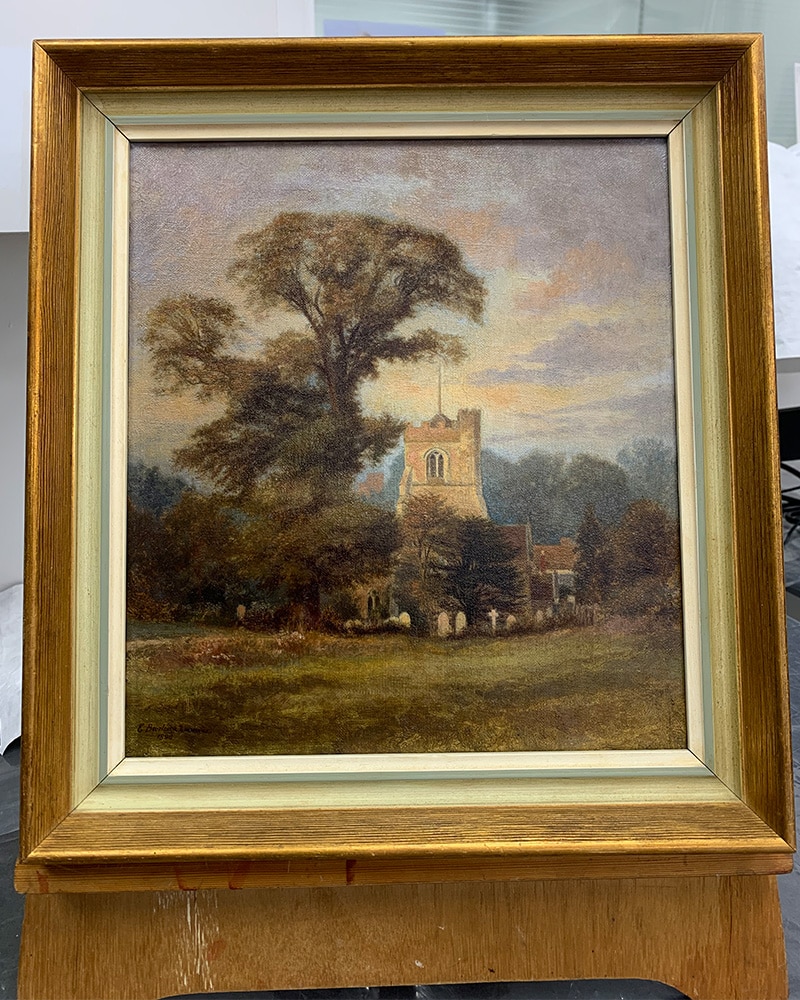
This small oil on canvas of a country churchyard came into our painting restoration studio with two punctures, an abrasion and some warping towards the centre of the painting.
The first stage of restoring the painting was to dust the back and front of the painting, using a small hoover to catch disturbed particles; and to dry clean the back and front of the painting. Discreet wet cleaning tests were then carried out to establish the optimum method of removing ingrained dirt and grime.
After flattening a prominent bulge in the painting, testing was then carried out by our painting restoration team to find the best solution for removing, or failing that, thinning the aged, discoloured varnish.
Once a method settled upon, and the old varnish removed; the colours in the painting immediately appeared brighter.
Our painting restoration team consolidated areas around the punctures and restored and filled the two holes to create a more uniform surface. Texture was added to the fills to ensure a seamless blend with rest of the canvas and then they were carefully retouched with watercolours.
Once the watercolour retouching was complete, the first coat of varnish was applied. Once this was dry, the painting was retouched using restoration paints. A final layer of varnish was sprayed on the painting; and the painting returned to its frame, which had also undergone treatment in our studio.
The owner of the painting was delighted with the transformation, writing: “May I say, once again, how thrilled I am with the painting and frame – many many thanks to Phoenix for turning my personal catastrophe into such a delight!”
Mural Painting Restoration
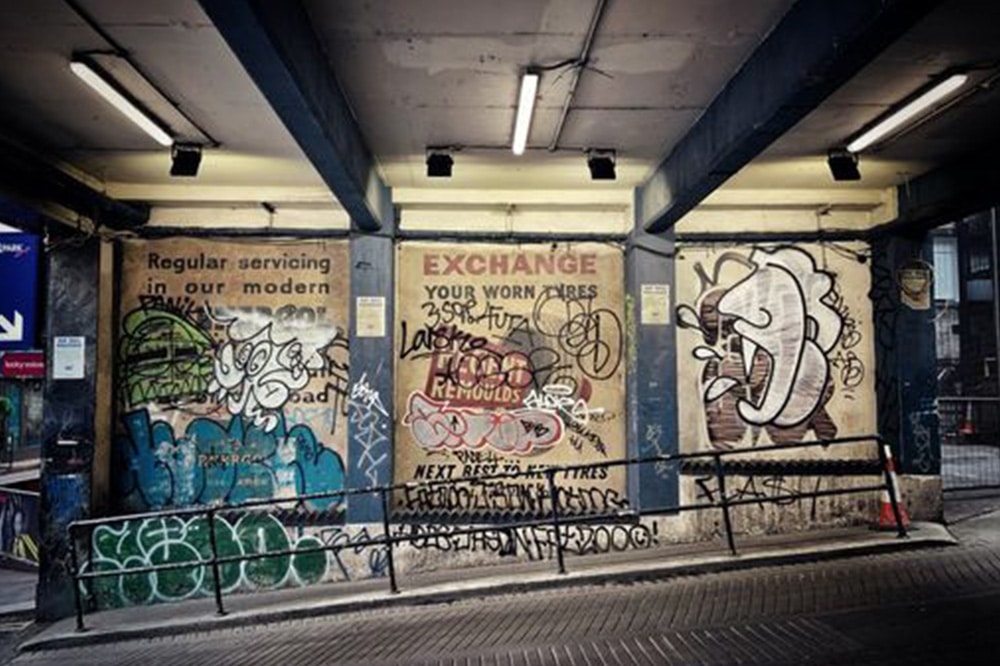
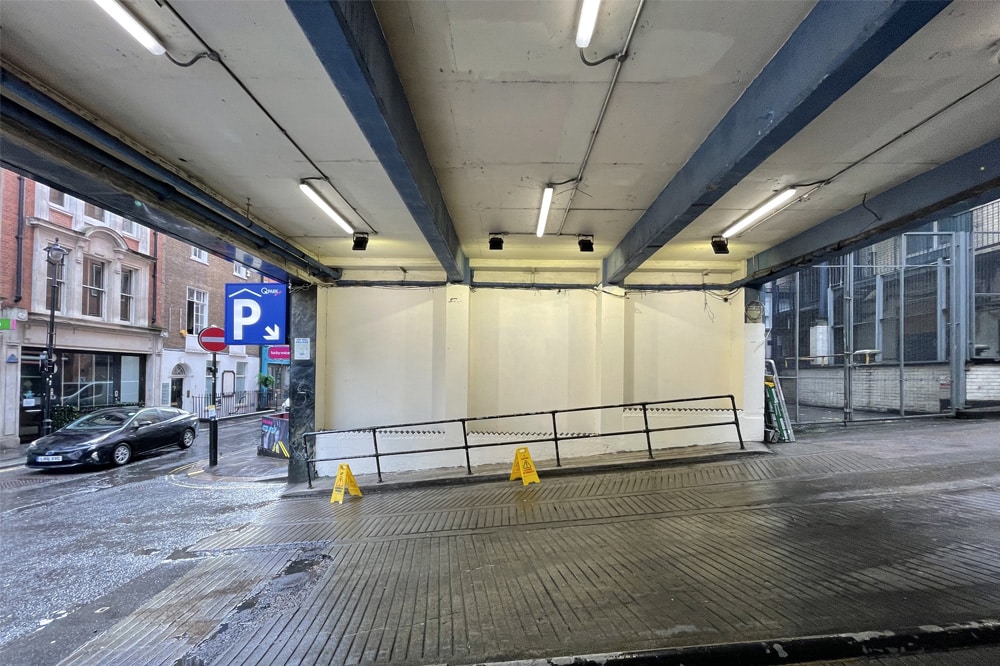

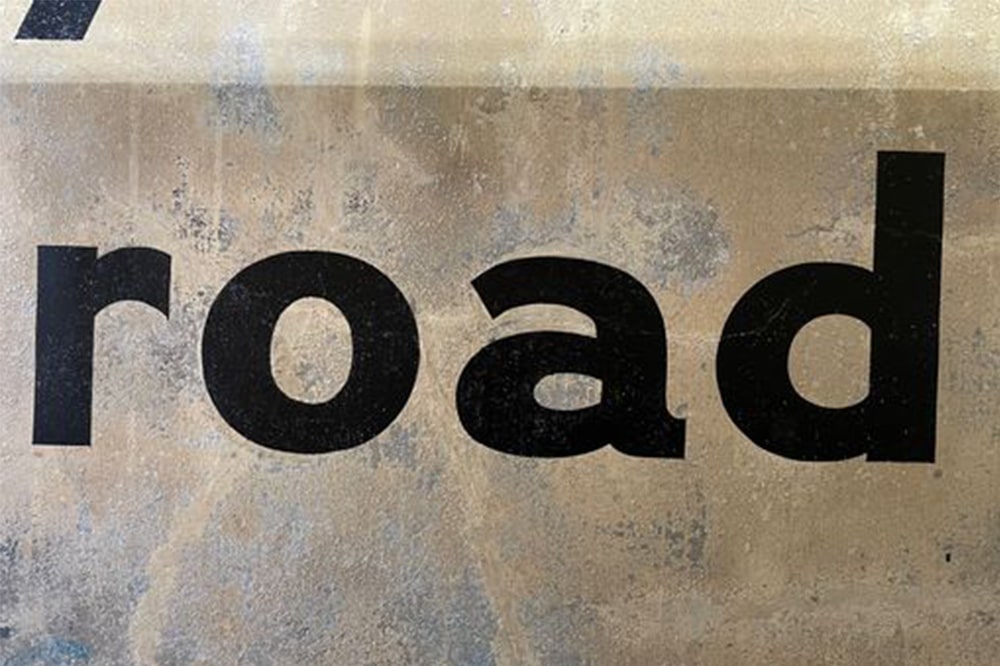
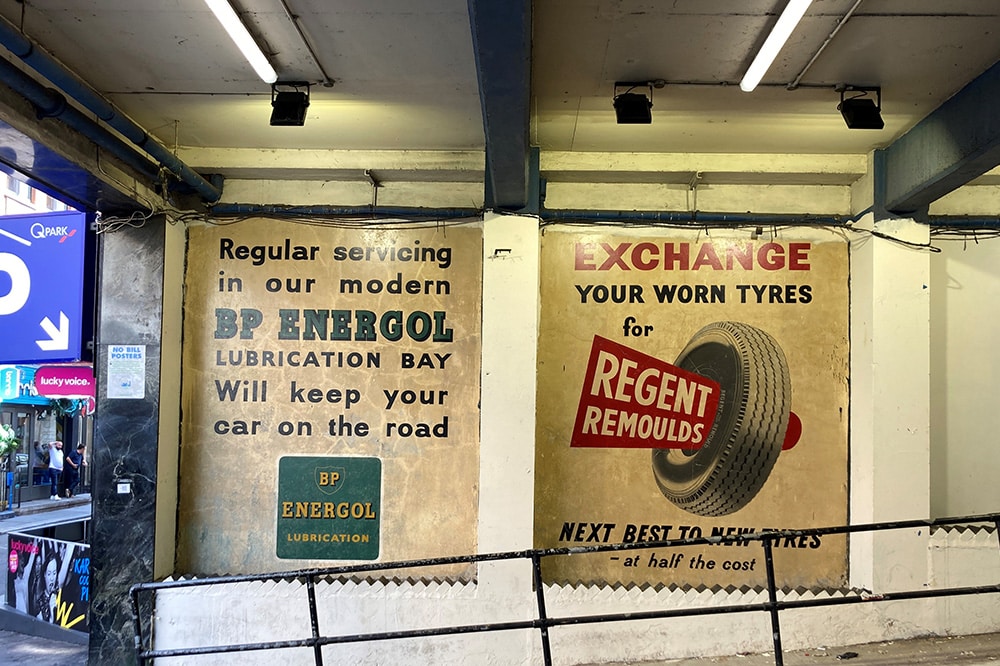
One particularly interesting painting restoration project of ours was carried out on behalf of Westminster City Council and involved the comprehensive restoration of two 1950s murals advertising BP Energol and Regent Remoulds (both car servicing companies).
These two 1950s BP Energol and Regent Remoulds advertising murals are located at the entrance of a multi-storey carpark on Poland Street, Soho. Since the late 2000s, both murals had been gradually covered over by different graffiti tags and throw-ups. By the beginning of 2021, the repetitive act of graffitiing over the murals finally led to the surfaces being completely overpainted with a thick layer of industrial household emulsion paint.
After reviewing pictures of the exposed murals, eight areas for graffiti removal testing were chosen by our painting restoration team to help them establish the optimum method for removing both the layer of white household emulsion overpaint and the graffiti.
Following rigorous testing, the white overpaint and graffiti were successfully removed using mechanical techniques, combined with solvent based solutions to soften paint areas and remove paint residues.
After the overpaint was removed, the now-revealed original murals were carefully surface cleaned to remove any residual dirt and historic soiling. Consolidation of structural issues encountered during the cleaning process, was carried out using emulsion-based adhesives.
Finally, a sacrificial protective wax layer was applied to the paint surface to ensure that any future graffiti could be easily removed without undue risk of the murals themselves being damaged.
17th Century Portrait Painting Restoration
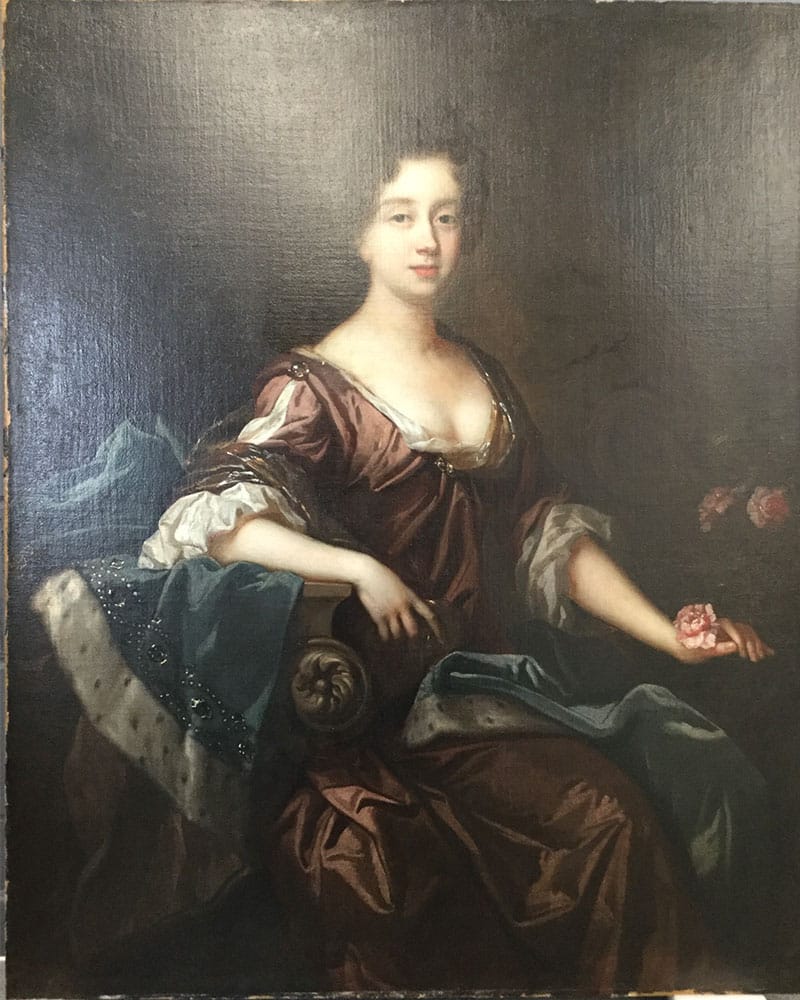
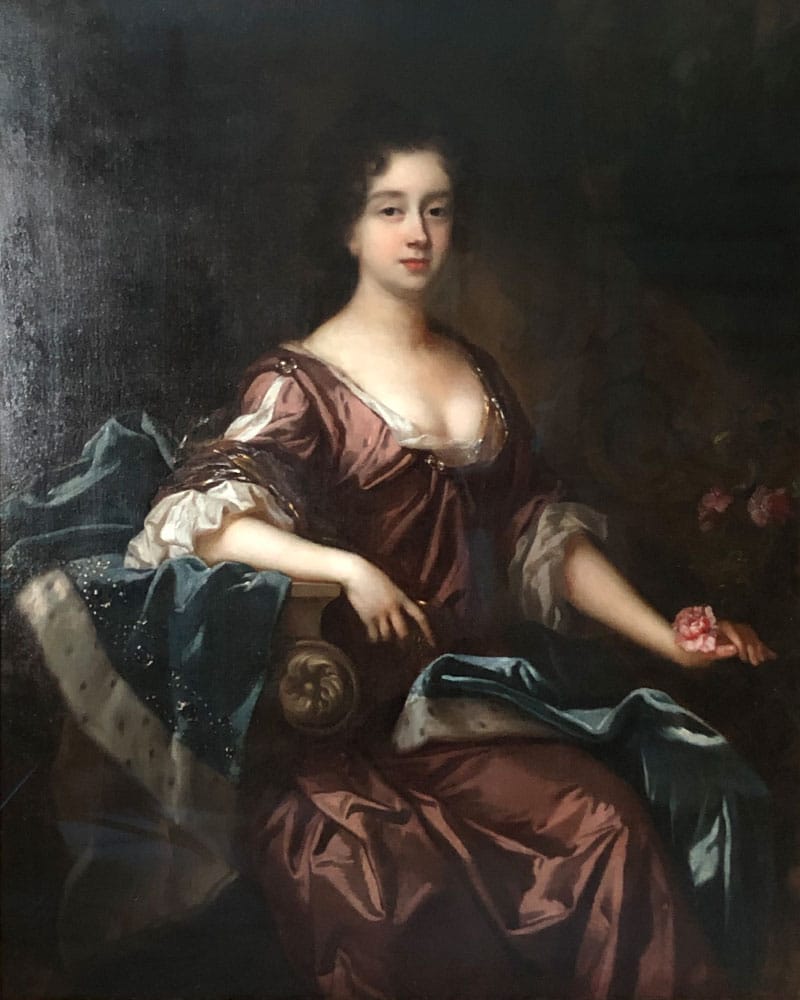
This 17th Century John Riley (1646 – 1691) oil painting of Sarah, Viscountess Castleton came into our studios for painting restoration treatment after the team at Valence House Museum observed paint lifting from the canvas.
After examining the painting under UV light, our painting restoration team concluded that the flaking in the paint was a long-term issue.
Our painting restoration team also noted that the painting’s original canvas had been previously relined and restored, and whilst this previous relining had preserved the tacking edges in places, the original canvas was now highly oxidised and brittle. These previous painting restoration treatments had focused on removing the yellowing varnish covering the sitter, meaning that by the time the work came into our painting restoration studio, the background depicted in the painting was concealed by a thick oxidised black layer.
Once our painting restoration team had removed the surface dirt, trials were conducted to find the optimal method of varnish removal. Removing the aged, discoloured varnish revealed a number of details about the painting, including trees and shrubs in the landscape and establishing that the flowers held by the sitter were roses, not chrysanthemums, as previously recorded.
Once clean, the canvas was de-lined before being relined, reusing the replacement stretcher from the previous restoration.
Our painting restoration team then applied an isolating varnish to the canvas, and filled and retouched any losses to the paint using a bespoke varnish, mixed with pigments. A final varnish was then applied by both brush and spray to even the surface coating.
Once dry, the painting was reframed behind non-reflective museum glass and returned to its newly restored frame that had received treatment in our Decorative Arts studio.
19th Century Oil Portrait Painting Restoration
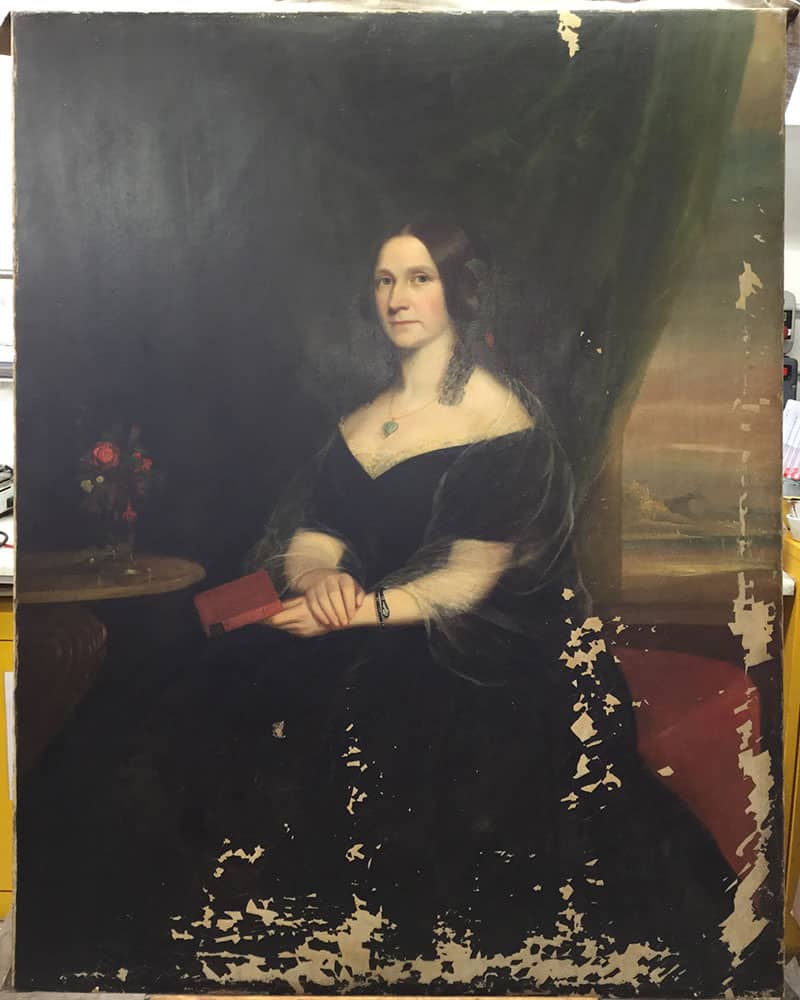
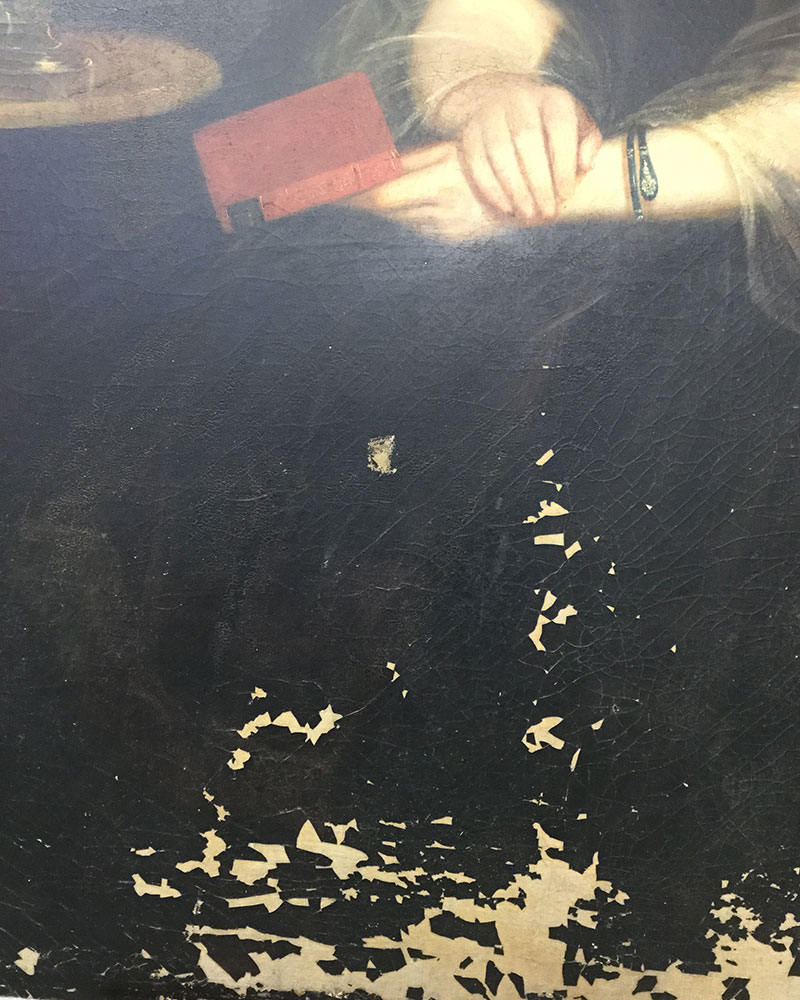
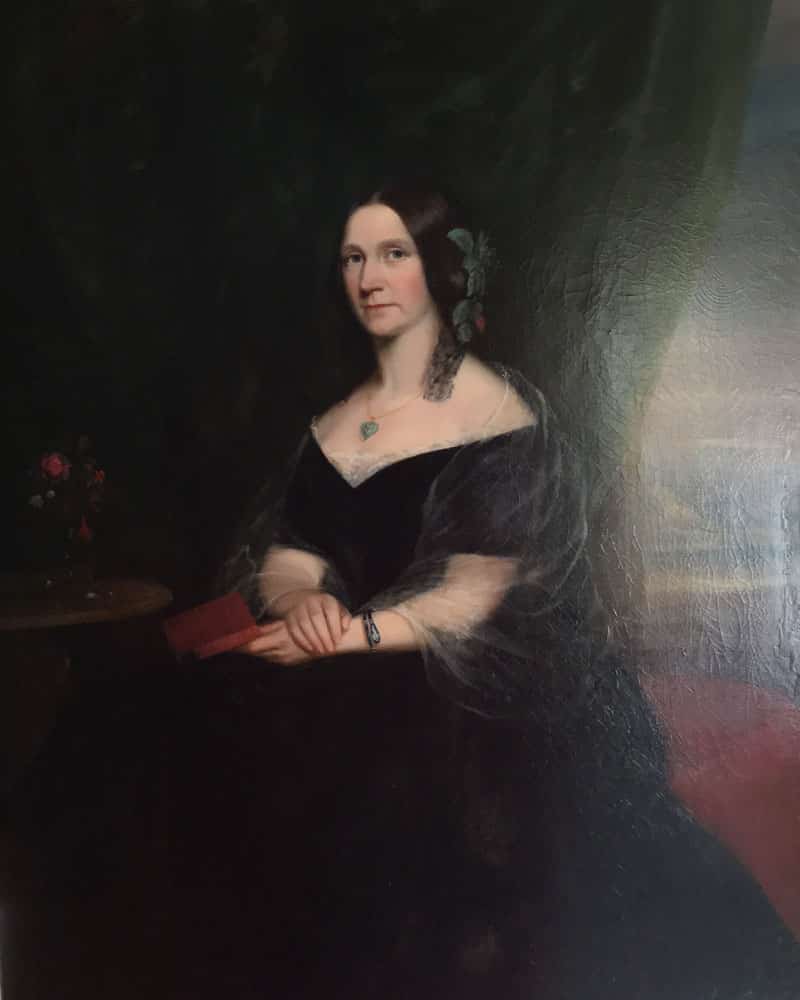
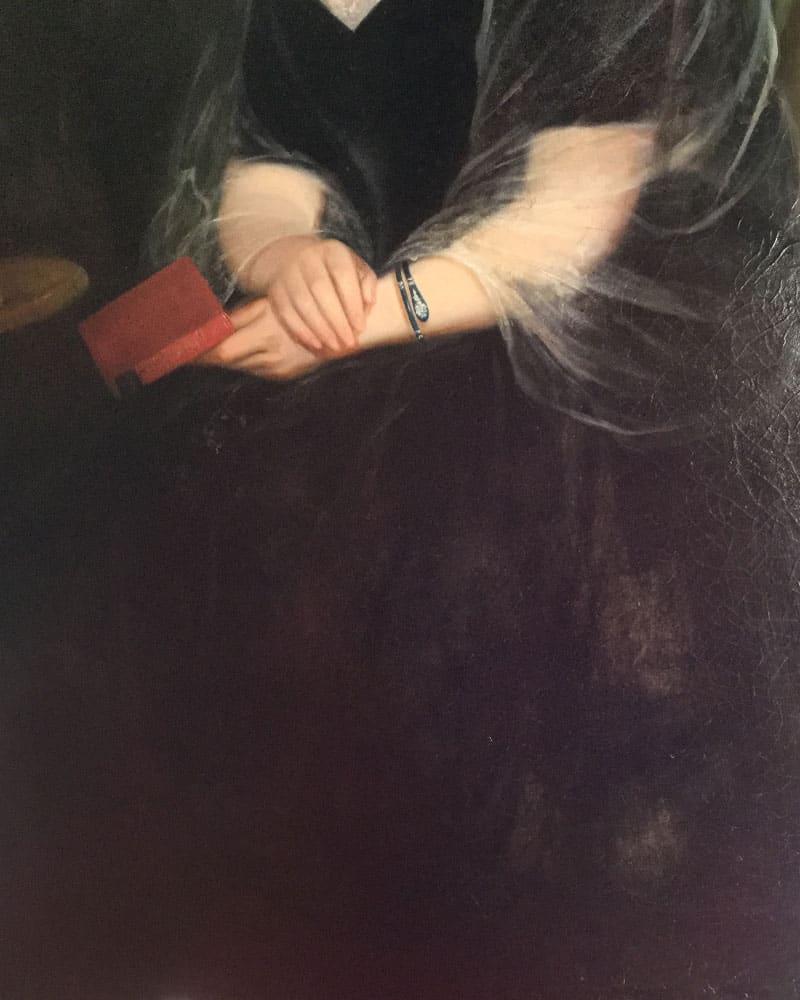
Prideaux Place in North Cornwall, is an historic house used in the filming of the Poldark TV series.
A house flood caused by an escape of water led to a number of historic family paintings and their impressive gilded frames sustaining significant damage.
These paintings subsequently came into our painting restoration studio for a complete programme of treatment. The paintings were surface cleaned and relined to stabilise the flaking paint. Pint losses were filled and retouched and a conservation-grade varnish applied to further improve the appearance of the painting and to help protect the painting from further damage.
The painting’s gilt frame also required some restoration work, including recreating missing sections of gilded gesso detailing. To see how we restored the gilt frame, please visit our Picture Framing page.
Surface Cleaning an Oil Painting
Accumulative dirt is carefully removed from the surface of this oil painting, as a first stage of the cleaning process. After all the surface dirt is removed, discreet patch tests will be carried out to establish the correct combination and concentration of solvents to remove traces of discoloured varnish without disturbing the pigments. At this stage, any detached flakes of paint can be reattached, or if these fragments are missing, these losses toned in.
Slashed Painting Restoration
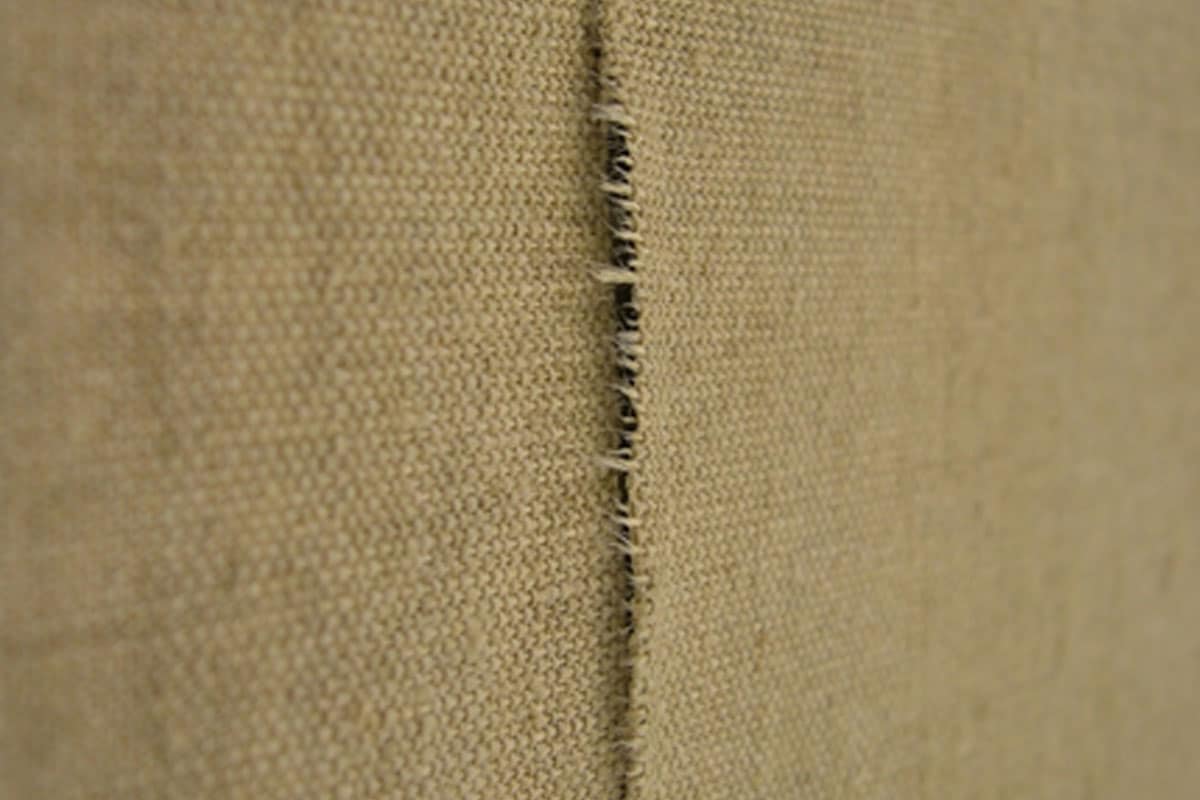
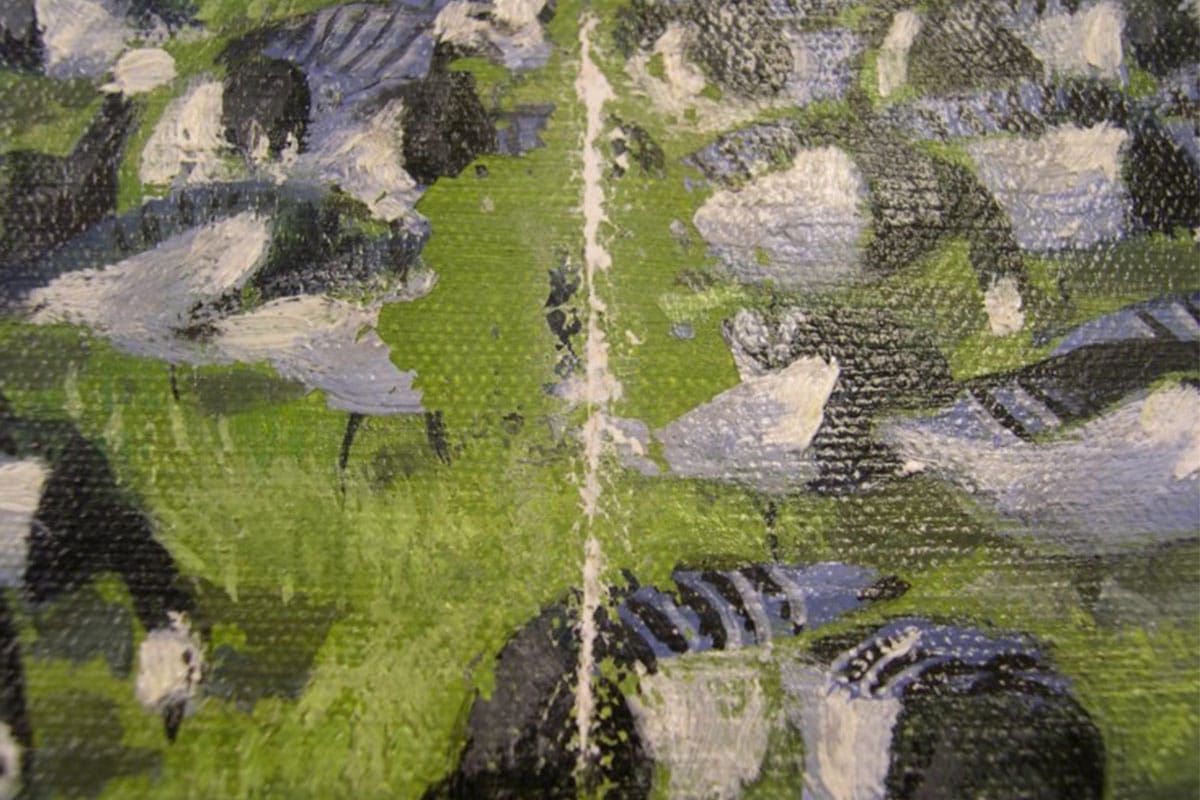
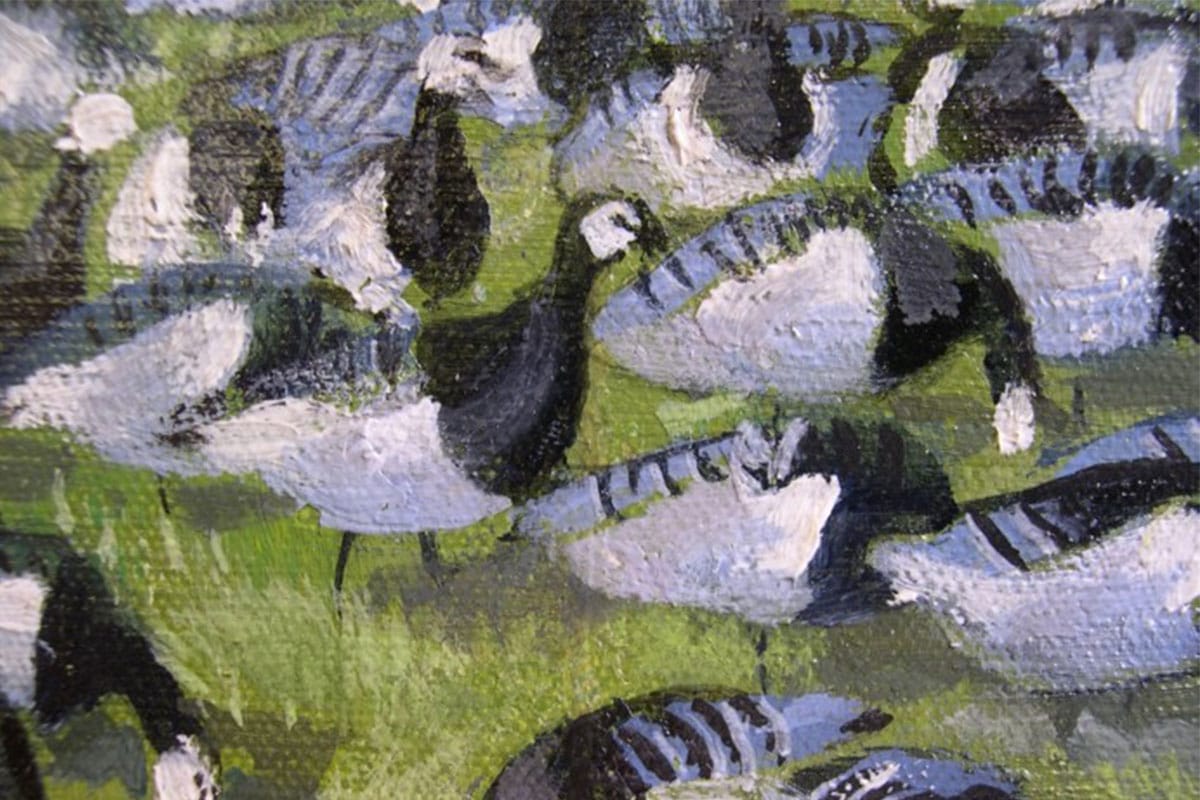
Paintings are sometimes inadvertently slashed when being unwrapped with a knife to remove protective packaging.
To restore this oil on canvas; our painting restoration team used a thread-by-thread tear-mending technique known as reweaving. This resulted in a strong local repair and avoided the need to reline the entire canvas. The damaged area was then filled and retouched to reintegrate the repair into the surrounding paint.
Family Portrait Oil Painting Restoration
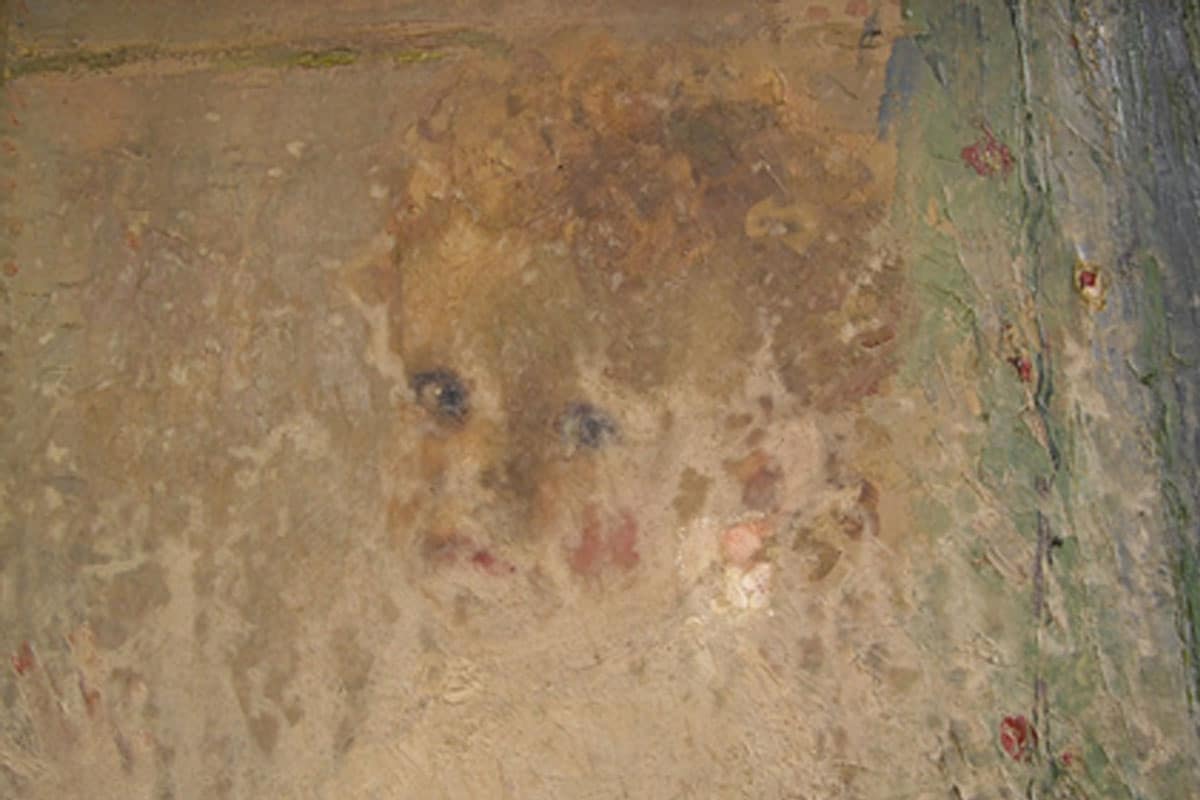
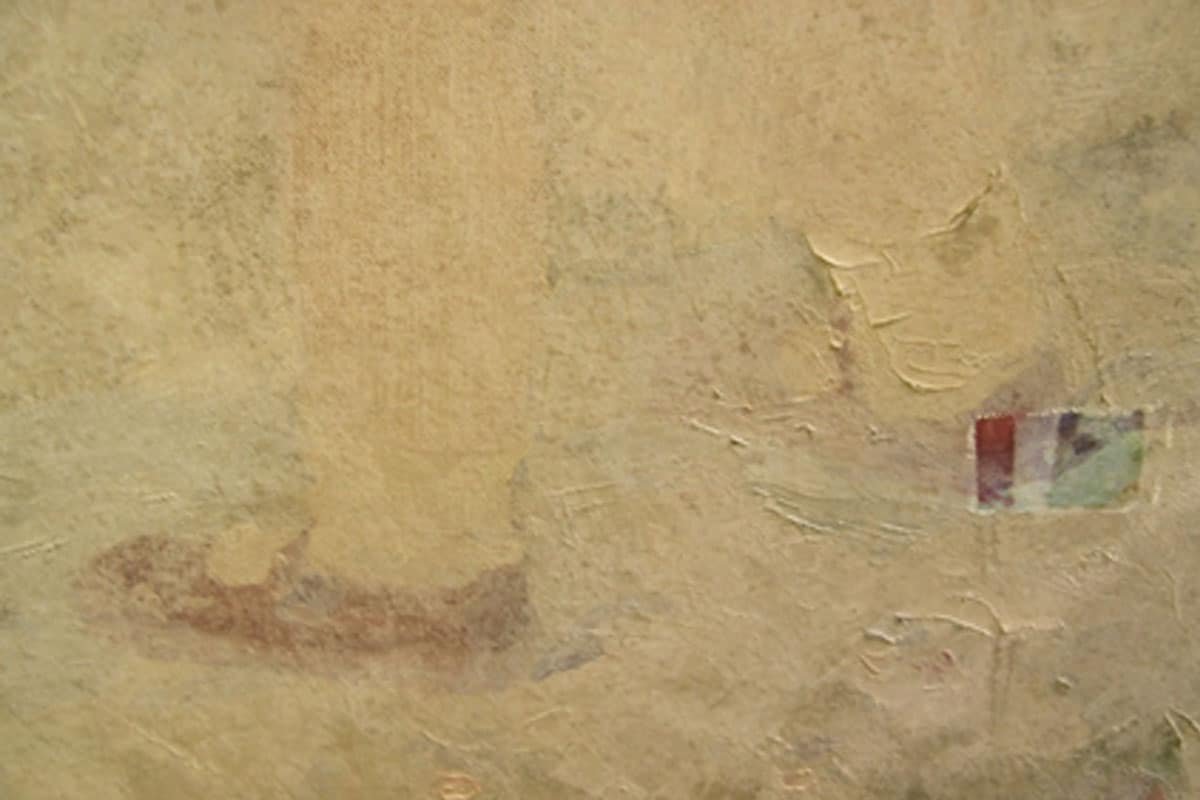
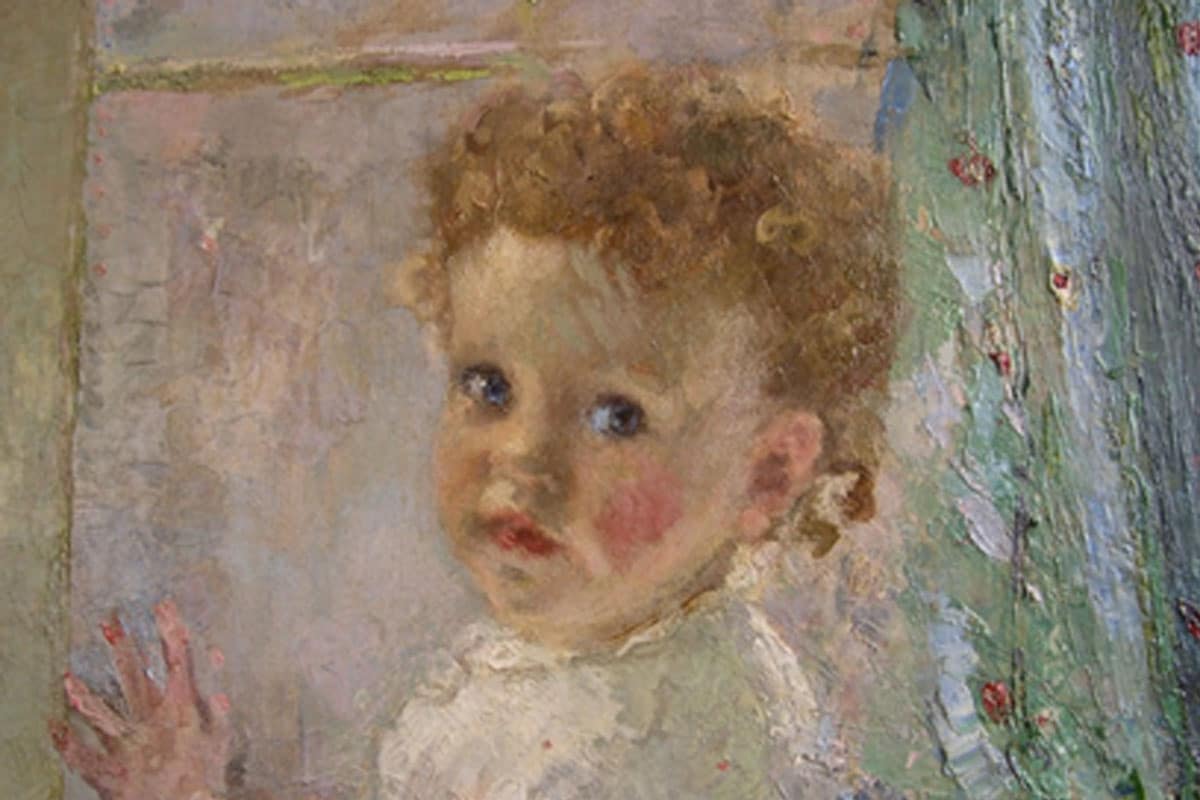
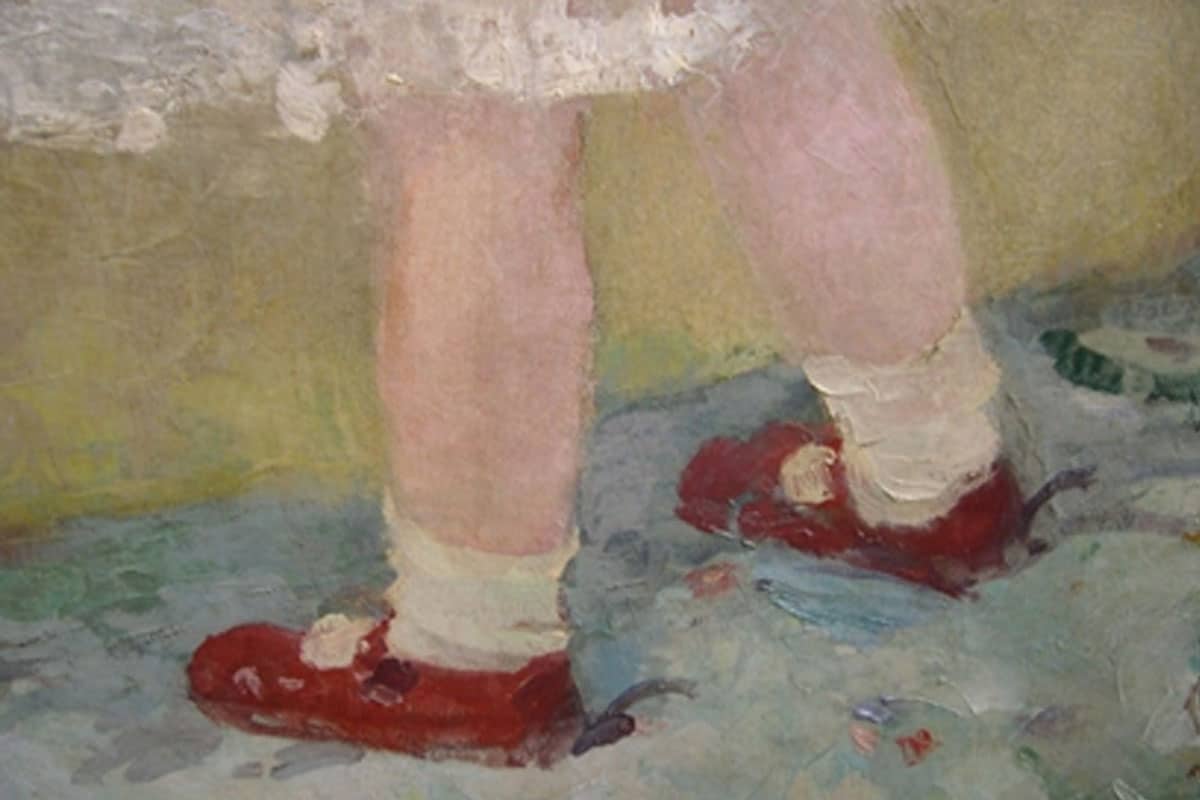
This much-loved family portrait had suffered as a result of being in a house fire. In addition to soot deposits, the painting was subjected to water damage, and at first glance, the painting appeared to be unsalvageable.
Following tests in our painting restoration studio, it was discovered that the damage had only permeated as far as the layer of varnish, which is applied as a sacrificial coating to the surface of the painting to protect it.
The blanched varnish was painstakingly removed, and our painting restoration team then cleaned and re-varnished the painting to protect the family portrait for future generations.
Painting Restoration Frequently Asked Questions
Why have a painting restored?
What sorts of paintings do you restore?
Painting restoration services we offer include:
• Acrylic and vinyl painting restoration and conservation
• Gouache painting restoration and conservation
• Restoration and conservation of antique miniature paintings
• Watercolour painting restoration and conservation (please note that Plowden & Smith has a specialist conservation department for the treatment of works on paper, which would include most watercolours)
• Modern and contemporary painting restoration, including paintings incorporating found materials, or unusual materials typical of the period, for example household emulsions and enamel paints in mid-century works.
• Street art conservation, including spray paint on canvas, board, metal, concrete. We also restore and conserve street art in situ.
• Wall painting and decorative schemes of all ages and media
If your painting falls into a category that you do not feel is covered by the above list, we will almost certainly have the expertise and experience to restore it the highest standards. Please contact us with more information about your painting and we can advise.
What sort of painting restoration treatments do you carry out?
Painting restoration and conservation typically falls into two categories, structural painting restoration and surface painting restoration.
What Training and Experience Do your Painting Restorers have?
Our Painting Conservator Nao Ikeda has a wealth of experience in the conservation and restoration of easel and panel paintings. Previous roles include working as Senior Conservator for the National Research Institute for Cultural Properties, Tokyo. Nao has also worked for the Tajikistan National Museum, and undertaken commissions for the National Portrait Gallery, Apsley House, and Kenwood House.
Originally from Japan, Nao holds a degree in Oil Painting from the Joshibi University of Art and Design, Tokyo, Japan. She then studied easel and panel painting restoration at the Università Internazionale dell’Arte, Florence, followed by a graduate internship at the Laboratorio di Restauro dell’Opificio delle Pietre Dure, Florence.
Having trained in Italy, Nao has worked on many canvas and panel paintings from the Renaissance period, including Fra Angelico’s Thebaide, Masolino da Panicale’s Storie di San Giuliano and Maestro di Rosano’s cross. Nao’s work restoring the Rosano Cross was published in the book “La Croce Dipinta dell’abbazia di Rosano – Visibile e invisibile. Studio e restauro per la comprensione” (edited by M. Ciatti).
Nao has substantial experience working on paintings of the 17th, 18th and 19th centuries, including works by the artists Bartolomeo Bimbi, Tommaso Salini and Èlisabeth Vigèe Le Brun.
What is a painting lining and why is it so important?
I've just bought a painting. What can I do to take care of it, whilst also enjoying it?
Is it worth getting my painting restored?
Many clients bring us paintings they have inherited. Often these works have historically been kept in conditions which are less than ideal, for example at some point in their lives they may have been hanging above a smoking fireplace, or spent many years in a reception room at a time when smoking indoors was more common, or alternatively they may have been stored in a damp basement, garage or shed. These works are often utterly transformed by straightforward procedures like surface cleaning, and their owners had no idea that their painting – or possibly great grandfather’s masterpiece – could ever look as good as it now does. Not only do these treatments give a whole new lease of life to the painting, but they often completely revive the room in which the painting is displayed.
How much does it cost to get a painting restored?
Will restoration add to the value of my painting?
Do you value paintings?
To find out more about our fine art restoration services, or to discuss a project
